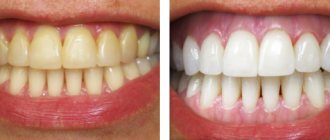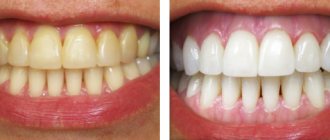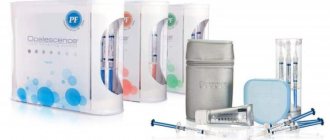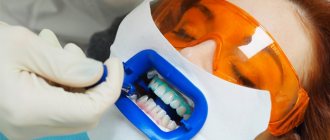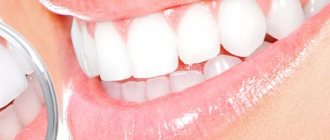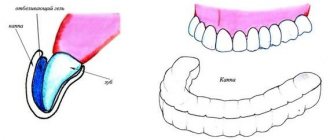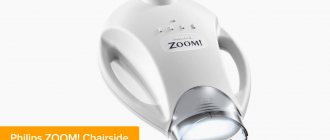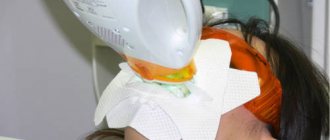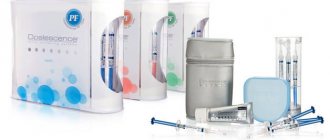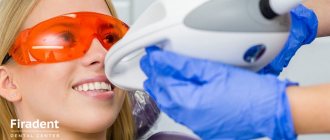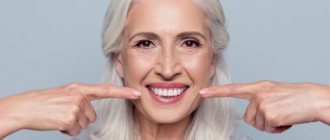One of the most popular services in cosmetic dentistry today is teeth whitening. In no way related to medicine, nevertheless, it is in great demand, because... in the minds of many of us, it is white (light) teeth that are an indicator of their health, as well as the high social status of their owner.
As I wrote earlier, such ideas were not always dogma, and how long such a fashion will last is unknown, but today it is so. I myself am neither a supporter nor an opponent of this procedure, and therefore I will try to talk about whitening as objectively and unbiasedly as possible. Moreover, I will do this in the form of questions and answers (i.e., a kind of FAQ on teeth whitening).
What is whitening and how does it differ from professional cleaning?
Very often patients say: “I want to whiten my teeth because... they have stains from coffee and cigarettes.” At the same time, they confuse 2 different procedures - teeth cleaning and teeth whitening. If brown plaque has accumulated on your teeth or stones have formed, then you need professional teeth cleaning, which is carried out with ultrasound, sandblasting (air-flow) or simply with a brush and a special professional abrasive paste. In this case, the dentist simply removes plaque from the surface of the teeth without changing their natural color. Although they become lighter, this is not bleaching. The whitening procedure involves the use of a strong oxidizing agent to lighten the actual tooth tissue. Hydrogen peroxide or carbamide peroxide, familiar to any unnatural blonde, is used as an oxidizing agent (it is approximately 2 times weaker than hydrogen peroxide). Penetrating into the internal structures of the tooth, the released active oxygen destroys the molecules of natural pigments, which leads to the fact that the tooth becomes lighter.
This is what plaque on teeth looks like, resulting from the abuse of cigarettes, coffee, and strong tea. It can be removed by professional cleaning, which has nothing to do with bleaching.
The essence of lamp whitening
It cannot be said that in this procedure, whitening occurs thanks to the light produced by the LED lamp. The bottom line is that light is only a catalyst for a chemical reaction between the reagent and the pigments that are inside the enamel and are responsible for its color.
In order to neutralize the yellow tint, a special gel based on hydrogen peroxide is applied to the teeth. Light exposure to this substance activates oxygen, which penetrates the tooth tissue and oxidizes pigments. Thus, light rays stimulate the chemical process, making the procedure safer and faster.
The main advantage of this method is that the light from the LED lamp practically does not heat the enamel, and therefore does not harm it.
What types of whitening are there? Which whitening method is more effective?
If we talk about really effective whitening, then there are only two types. Office and home. I repeat once again that the essence is the same everywhere. What's the difference then? Office work, as you might guess, is carried out in the dentist’s office. It is produced by gels with a high concentration of bleaching agent (usually 35-38% hydrogen peroxide). You cannot do procedures with such concentrations yourself, because contact of the gel of such concentrations with the mucous membrane causes severe burns. The doctor uses numerous means of protection so that only the teeth are whitened, and not the tongue or lips. Some whitening systems (Zoom, LumaCool, etc.) involve activating the gel with a special lamp for a faster and more effective procedure. Some are simply applied to the teeth and work without any additional activation by light (Opalescence, Bleach n' Smile , etc.) In any case, the procedure takes about 1-1.5 hours and the result can be seen almost immediately. Especially in systems with light activation of the gel.
This photo shows the process of in-office whitening with the Opalescence XtraBoost system, which I prefer to use in my practice. The green arrows indicate the actual whitening gel (38% hydrogen peroxide), the blue arrows indicate the protective coating of the gums (the so-called “liquid dam”), the black arrows indicate a temporary plastic crown, which does not whiten and will be replaced with a permanent one after completing the whitening course.
Home whitening involves the patient performing the procedure independently at home. BUT! Under the supervision of a doctor exclusively! Ideally, you come to the doctor, in 1-2 days they make a special plastic individual mouthguard for your teeth, give you instructions on what gel, what concentration and according to what scheme is best to use in your case. And then at home you do everything exactly as the doctor ordered. Results can usually be seen within a couple of weeks. Exactly the same result as with the cabinet version.
The custom tray is filled with whitening gel and placed over the teeth. Mouthguard wearing patterns vary and must be selected individually by the dentist.
Let's summarize the pros and cons of teeth whitening options . In-office treatment is faster, but it is usually more expensive and is often associated with the appearance of unpleasant sensitivity, both during the procedure and for some time after it. Home whitening will give a similar result over a longer period, but it is cheaper and, as a rule, does not cause discomfort in the form of increased tooth sensitivity. In cases where the result is not required right now (unexpected wedding, urgent important date, etc.), it is better to choose home whitening. But if you are not confident in your accuracy, you don’t want to spend a long and tedious time remembering all the rules and following all the recommendations, prefer a less complicated office option.
If you suddenly have an important event in your life that you need to approach with a dazzling smile, then in-office whitening is your choice.
The truth about periodontitis: if you want to keep your teeth and health
The lack of competent information from the patient regarding gum disease and timely professional treatment unfortunately leads to very sad consequences - loss of teeth, and can also threaten a person’s overall health. To prevent them, we talked with the leading periodontist, therapist and surgeon at the Elite Center Clinic, Marina Mikhailovna Shakirova.
Periodontal disease is a disease of the gums and bone surrounding the tooth.
The following stages of gum disease are distinguished:
- Gingivitis is inflammation of the gums caused by plaque.
- Periodontitis is an inflammation of not only the gums, tooth ligament, but also the bone tissue surrounding the tooth.
- Mild periodontitis (I)
- Average degree of periodontitis (II)
- Severe periodontitis (III)
Tab. 1. Signs of the disease
| Gingivitis | I Art. Periodontitis | II Art. Periodontitis | III Art. Periodontitis |
| Blue-red gum color. Swelling and bleeding of the gums when brushing teeth and eating solid foods. Smell from the mouth. Pain (itching, burning) in the gums. | Bleeding gums. The space between the roots of the teeth and the gum (gum pocket). Bad breath. Sore gums. Hypersensitivity of teeth. | ||
| The depth of the gum pockets does not exceed 4-5 mm. | The depth of the gum pockets is 5-6 mm. Exposure of the tooth root. Mobility of teeth. | The depth of the gum pocket is more than 6 mm. Severe tooth mobility and exposed roots. | |
How does the disease occur? After each meal, a small amount of food debris remains on the teeth and between the teeth, which forms a soft plaque. This plaque is difficult to see; oral microorganisms immediately settle in it. Microbes and their metabolic products are deposited on the surface of the tooth and lead to gum inflammation. Gradually accumulating, plaque becomes hard, turning into tartar, which increases inflammation.
So, what every person, especially those suffering from periodontitis, needs to know:
1.100% OF DENTAL CLIENTS HAVE GUM DISEASES.
In 98-100% of patients who come to the clinic with oral problems (caries, etc.), we detect varying degrees of periodontal disease. In addition, 100% of people who smoke suffer from periodontitis!
2.PERIODONTITIS IS A MORE INSANE AND DANGEROUS DISEASE THAN DENTAL CARIES.
There can be no healthy teeth without healthy gums! The teeth may not be affected by caries, but we will lose them because the bone has left the interdental spaces.
3.PERIODONTITIS CAN SIGNAL ABOUT HIDDEN DIABETES!
Of course, the main cause of gum disease is improper and irregular oral hygiene!
BUT! You need to know that PERIODONTITIS is an autoimmune disease (autoimmune diseases are diseases associated with dysfunction of the human immune system, which begins to perceive its own tissues as foreign and damage them).
And diseases such as diabetes mellitus, diseases of the thyroid gland, adrenal glands, systemic osteoporosis, blood diseases, etc. lead to changes in the periodontium. A patient suffering from periodontitis may not even be aware of the hidden course of these diseases.
And for patients with these diseases, it is imperative to see a periodontist.
But! It is useless to treat periodontitis if the patient does not treat the underlying disease (diabetes mellitus, hormonal problems, blood diseases).
4.PERIODONTITIS CAN CAUSE ARTHRITIS, GASTRITIS AND OTHER DISEASES!!!
Periodontal pockets are a source of chronic infection. It has been proven that the long-term presence of infection in the periodontal pocket leads to the development of diseases: rheumatoid arthritis, atherosclerosis, endocarditis, gastritis, etc.
5. PERIODONTITIS MAY NOT MANIFEST FOR LONG YEARS - IT CAN ONLY BE DIAGNOSED BY A DOCTOR!
The insidiousness of the disease is that it does not manifest itself for many years. Only a doctor can make a timely diagnosis and prescribe treatment by examining the oral cavity and x-ray examination (orthopantomogram or computed tomogram (CT)). In addition, we definitely prescribe an additional examination if we see an aggressive course of the disease, exacerbation, mobility, halitosis (bad breath) and, according to X-ray data, significant loss of bone tissue.
A general examination includes blood biochemistry, a complete blood count, an analysis for latent hemoglobin, and the laboratory data obtained very often reveals latent and already progressive forms of diabetes mellitus (in young people). Very often a blood disease is detected.
“REJUVENATION” OF DISEASES – EVEN 16 YEAR OLD PEOPLE ARE SICK.
A feature of the current situation with gum disease is the “rejuvenation” of this process. If earlier this disease was detected after 45-50 years, now we can detect it at 16 and 18. This is usually associated with poor hygiene and crowded teeth. Especially if orthodontic problems are not treated. Moreover, the younger the patient, the more aggressive the course of the disease!
IF A PERSON IS SICK WITH PERIODONTITIS – IT IS FOREVER!
Periodontitis is an autoimmune disease; we can only bring it into remission and prevent further progression. A 100% cure occurs only with gingivitis (if the patient follows the recommendations).
If periodontitis is simply treated once, the effect is lost instantly. Any periodontal disease requires dynamic observation, that is, the so-called dispensary observation, supportive treatment and an invitation to attend MPT (maintenance periodontal treatment). The first examination is after 1 month, the 2nd procedure is after 3 months, then every 4 months. At the Elite Center Clinic, we keep a mandatory journal in which we record the schedule of visits the patient needs and invite him in advance.
GINGIVIT IS 100% ACCOMPANYING PREGNANCY.
Since during pregnancy, hormonal levels change, which leads to changes in the composition of plaque. It is believed that all patients with periodontitis have an increased risk of having a low-birth-weight child, and the source of infection can lead to the early development of caries in babies, and bacteria contained in the discharge from periodontal pockets can provoke miscarriage. This is a proven fact. Therefore, if pregnancy is planned, then it is necessary to undergo treatment by a periodontist and be observed by a periodontist during the 1st and last trimester of pregnancy.
SO HOW TO CORRECTLY TREAT GUM DISEASES?
Traditionally, there are 3 STAGES in periodontal treatment:
STAGE 1 OF TREATMENT:
This is the stage of PROFESSIONAL HYGIENE or otherwise – the closed curettage procedure.
Closed curettage includes:
- professional removal of plaque, tartar (using ultrasound and air-flow)
- root cleaning and polishing.
At the Elite Center Clinic, our patients also have access to the most modern hardware treatment for periodontitis, which often allows us not to proceed to the 2nd stage - surgical treatment:
1) FotoSan device (manufactured by CMS Dental, Denmark) As a result of light photoactivation, oxygen is released, which destroys pathologically altered cells and inflammatory microflora in periodontal pockets. Active oxygen acts instantly, safely, without side effects and eliminates the need for antibiotics.
2) Prozone device (W&H Dentalwerk Burmoos GmbH, Austria) In periodontics, the effectiveness of the Prozone device can hardly be overestimated, because it destroys bacteria in the gingival pocket, which are very difficult to reach, since they are in a biofilm. Bacteria become coked and live there in colonies. With Prozone, ozone penetrates into any place to be disinfected and completely destroys pathogenic microflora, minimizing the risk of re-infection.
3) Vector device (Durr Dental, Germany) The use of ultrasonic energy simultaneously with a jet of highly dispersed suspension of hydroxypatite powder allows you to remove infected granulation tissue, biofilm, plaques, and tartar. At the same time, waste products of microorganisms are washed out. This gives a powerful regenerating impulse and anti-inflammatory effect.
This same stage includes active rinsing with antiseptics and medicinal dressings. With these methods we can stop not only mild, but also moderate periodontitis!
STAGE 2 – SURGICAL TREATMENT
Classical periodontics recommends the use of surgical treatment methods if the pocket is more than 5-6 mm. But how are we doing at the Elite Center Clinic? If the use of all stage 1 treatment methods and laser technologies leads to stabilization, then we do not resort to surgical treatment. That is, if 3 months after the 1st stage of treatment the patient is not exacerbating, then we conduct a course of maintenance periodontal treatment even with a severe form, if it is in a stable phase.
But in any case, severe and aggressive periodontitis requires ONLY COMPREHENSIVE TREATMENT!!! Together with an orthopedist, together with an odontist, together with an endocrinologist, a therapist, a cardiologist.
General somatic diseases are contraindications for surgical treatment.
Before surgery, tooth mobility is prevented - the splinting method is used: we cannot operate on mobile teeth (otherwise they may take the wrong position).
Surgical treatment involves detaching the gum, cleaning the root from subgingival stone, polishing the root, filling this space with a protein-matrix complex or artificial bone, putting the flap back and suturing it. The roots are exposed.
At the Elite Center Clinic, surgical treatment is mandatory with the Emdogain protein-matrix complex.
Emdogain is a drug with a biological composition that promotes predictable restoration of both hard and soft tissues. But! It leads to an increase in bone tissue volume by only 0.5 - 1 mm. The process of bone destruction stops, but new bone does not grow. When applied to the surface of the tooth root, after cleaning it, emdogain begins to imitate biological processes, stimulating the restoration of tissue around the tooth.
Upon completion of the operation, we prescribe dressings, antibiotics, immunocorrective therapy, antihistamines, rinses, and a certain hygienic regimen.
We can carry out all periodontal treatment procedures (quite painful) for our people under sedation and anesthesia!
TAKING SOME DRUGS CAUSE PERIODONTAL DISEASE.
Periodontitis can be detected as a result of taking certain medications, they cause the phenomenon of gum overgrowth. For example: Cyclosparins, drugs that reduce blood clotting, all hormonal drugs. Patients taking hormones should definitely be seen by a periodontist.
Very often we detect periodontitis after suffering severe diseases, for the treatment of which antibiotics were taken. After this, the plaque becomes viscous and easily adheres to the surface of the teeth, which leads to aggravation.
Periodontitis is always present with orthodontic problems.
HYGIENE, HYGIENE AND MORE HYGIENE!!!
The lack of DAILY proper oral hygiene in patients with periodontitis leads to an immediate aggravation - after 12 hours the plaque is fixed and ALL treatment comes to naught.
YOU MUST REMOVE PLATE AND FOOD REMAINS EVERY 12 HOURS!!!
The patient’s task is to come for examinations not in a state of exacerbation, but in a state of remission to a maintenance complex, because each episode of exacerbation leads to loss of bone tissue. We must not allow this to worsen!
During the appointment, we select individually for our patients, based on the indications: what toothpaste should be, what brush, what rinse, in what mode to use, when to replace, what medications to take.
When a patient is sick with acute respiratory infections, acute respiratory viral infections, influenza and other diseases of the upper respiratory tract, the viscosity of saliva increases and local corrective immune factors decrease (their level decreases in the oral cavity). This leads to the fixation of a more sticky plaque. Therefore, after almost all acute respiratory infections and acute respiratory viral infections, we note an exacerbation of processes in patients. During illness, hygiene should be increased. After (during) an illness, you should contact your doctor for corrections in the treatment program (changes in the cleaning regimen are possible, additional antiseptics are prescribed), and additional professional cleaning.
PROSTHETICS AND IMPLANTATION FOR PERIODONTITIS
It is mandatory to undergo periodontal treatment before prosthetics and implantation. Implantation for periodontitis - can be carried out only when periodontitis is in a stable phase; there should be no presence of supra- and subgingival deposits.
BE HEALTHY AND VISIT YOUR DENTIST ON TIME - THIS IS A GUARANTEE OF A HEALTHY AND BEAUTIFUL SMILE!
Sign up online
Registration Online
Will my teeth have sensitivity after the whitening procedure?
I began to partially answer this question in the previous paragraph. In each case, the manifestation of hypersensitivity during and after the procedure cannot be predicted; everything is quite individual. Generally speaking, the appearance of increased sensitivity of bleached teeth to one degree or another manifests itself after any whitening method. The faster the procedure occurs, the higher the concentration of the whitening gel, the stronger and longer the discomfort. Therefore, according to the degree of severity of unpleasant sensations, we can rank the procedure options as follows: in-office with the use of activating lamps gives complications more often and the intensity of unpleasant sensations is higher, in-office without activating the gel with light - less, home - least often, up to complete absence. One way or another, there is no need to be afraid of this. Usually, however, the sensitivity is not very intense and lasts a maximum of a few days. In addition, there are special products to reduce tooth sensitivity that you can use during this period. In some whitening systems, they come complete with all consumables for the procedure, and are given to you by the doctor.
Why do teeth become sensitive after whitening?
In the first days after the procedure, the enamel will be more sensitive; minor pain and reaction to temperature stimuli may occur. This is a completely normal phenomenon, since the teeth were exposed to aggressive external influences. However, there should not be acute pain - this situation indicates that the doctor chose the wrong dosage of the active substance.
Even the safest and gentlest whitening methods still have a negative effect on the enamel, destroying its mineral composition. Therefore, it is necessary to introduce healthy foods into the diet (see the list below), as well as use various preparations that will strengthen your teeth - in pharmacies you can purchase special pastes or compositions that are applied to the teeth for a few minutes.
Is teeth whitening a harmful procedure?
As one medieval doctor said, “All poison is just a matter of dose.” The same can be said here. It is no secret that there is absolutely no benefit from bleaching in the medical sense. But there will be no harm from a competently carried out procedure. Suffice it to say that in the USA the bleaching procedure is very popular, and is generally equated to hair lightening, because... they even carry it out in shopping centers, not seeing any sedition in it. Therefore, if you really want to, bleach it. Only under the supervision of a doctor. In addition, the teeth on which the gel will be applied must be healthy, they should not have leaky fillings or caries. The dentist should check all this before you go into all serious troubles. He should also choose the best whitening method specifically for you and your teeth . Suggest the correct scheme for using products for home use, explain the features of dental care, etc. and so on. In general, conduct a full briefing and control. Only in this case the procedure will be as safe as possible and will bring nothing but a refreshed, white-toothed smile (if you are dreaming of it).
Teeth whitening looks so unpretentious and mundane in many shopping centers in the United States. While your wife is replenishing her wardrobe, and her beloved mother-in-law is replenishing her refrigerator, you can lie down and benefit your appearance.
How effective and harmful are whitening toothpastes?
Here it must be said that the vast majority of so-called whitening pastes are actually not capable of whitening anything, because... they simply lack an oxidizing agent. So this is a kind of advertising ploy by the manufacturers. But what they do have is a higher content of abrasive substances for more effective plaque removal. You should not use such toothpastes regularly; it can cause serious harm to your teeth. At a minimum, this may threaten the appearance of increased sensitivity of teeth , and at a maximum, the appearance of non-carious lesions (mainly wedge-shaped defects). They can be used only temporarily (no more than one medium tube is used up) and it is advisable to alternate it with regular toothpaste. It is needed primarily by heavy smokers and coffee lovers. If you are not one of them, then you should not turn your attention to “whitening” toothpastes. In some rare cases, whitening toothpastes do contain small amounts of a bleaching agent. And such a paste really has the right to be called “whitening.” They are sold more often in pharmacies and are much more expensive than regular pastes. But even with regular use, you should not count on a noticeable effect from their isolated use. Concentrations are too low. As a rule, they are used for the period while the home whitening process is in progress to enhance and maintain the effect.
Here you can also talk about other “pharmacy” products for teeth whitening – various varnishes, strips, etc. All of these are very ineffective drugs for the same reason - a low concentration of the bleaching agent. To feel the results from them, you need to have a very high power of self-hypnosis. So it's just wasted money.
What effective folk whitening remedies exist? How to whiten teeth at home?
This question could be answered briefly: there are no effective traditional methods of teeth whitening . And I would like to warn against the thoughtless use of improvised means in order to save money. Very often this backfires. It is strictly forbidden to use soda, tooth powders, lemon, activated carbon, etc. to brighten your smile. in different combinations. I personally once had a patient who spent a considerable amount of time brushing her teeth with a mixture of baking soda and lemon juice. When she came to me, I learned for the first time what enamel erosion looks like. At that time I had not yet photographed clinical cases, but it looked something like this.
How do you like this “whitening”? Instead of beautiful teeth, they were irreparably damaged and their restoration cost her a lot of money. As usually happens, thoughtless savings turned into even greater expenses.
I also heard a story from colleagues about how one of the patients whitened his teeth with “Toilet Duck”, because the bottle said “safe for enamel.” Well, what else can you say?
to whiten your teeth on your own online . Most of them are just a waste of time. And some are simply harmful. So, in pursuit of beauty, do not lose your sanity, otherwise you risk losing your teeth. Ultimately, if you need to post your photo on a social network or forum, you can whiten your teeth using Photoshop (as they do in glossy magazines for unnaturally white-toothed models). Or if you need white teeth for some important occasion, you can visit the solarium several times, use a foundation of a darker shade... against the background of dark skin, the teeth will appear lighter even without any bleaching (just look at the “tanned” Africans, whose teeth are always appear dazzlingly white just because of the color of their skin).
What is real bleaching like?
Negative consequences of teeth whitening are possible if a whitening compound is applied to the crowns. It affects the structure of the enamel, destroys and washes out the yellow pigment. Before professional bleaching, it is necessary to carry out hygiene. Otherwise, the white color will “lay down” unevenly, which will look strange and unaesthetic.
To plan the final result of aesthetic therapy, dentists use a special scale. It is used to determine what tone the patient’s teeth have at the time of treatment (most often this is A3) and what he wants to have as a result of all medical procedures. Most people want to get shade A1 - it is the lightest on the scale.
Is it good? Striving for an unnatural white smile is not healthy. If your teeth are naturally yellow, you should not repeat the aesthetic treatment several times. It’s better to stop after lightening the enamel by several tones. Trying to get the smile of Hollywood stars can harm your own health.
Is it possible to whiten a dead, darkened tooth?
Yes, and this procedure is called endobleaching . Those. internal tooth whitening. It may be needed when, after removing a nerve in a tooth, for various reasons it becomes dark, turns yellow and begins to stand out from its healthy neighbors. In this case, access to the canal is made in the tooth, it is reliably isolated, and the same hydrogen peroxide/urea whitening gel remains in the cavity for 2-3 days. As a result, the darkening of the dead tooth can be eliminated. Often this procedure must be performed before prosthetics of the front teeth with metal-free crowns or veneers. Due to their fairly high transparency (which is very necessary from an aesthetic point of view), any change in the color of the tooth underneath will be unpleasant to show through. This may prevent you from making restorations of the same color.
Upper central incisor darkened after depulpation
The same after the internal bleaching procedure
How effective is teeth whitening with LED light?
Modern cold bleaching is a very effective method. Depending on your individual characteristics, in one visit to the dentist you can lighten your tooth enamel by about 6-10 shades. Provided that your teeth have acquired a yellow tint due to food or smoking. If your enamel has acquired a gray tint, lightening with an LED lamp will not give significant results, that is, the shade will change by 2-3 tones. In addition, the procedure will not work if a change in the healthy color of the enamel is caused by taking tetracycline antibiotics or an excess of fluoride in the body.
The results of whitening with an LED lamp can last for several years, depending on the natural shade of the enamel and how carefully you follow your dentist's recommendations.
What is restorative bleaching? Is it possible to whiten teeth with veneers?
Restorative bleaching is, in most cases, a great stupidity that some doctors suggest that their patients do to themselves. This procedure involves covering the front surface of the teeth with a thin layer of white opaque composite material (it was popular in the past), or the same white opaque ceramic veneers/lumineers. In both cases, an irreversible change in the surface of a healthy tooth is assumed. In the case of a composite, you get a very dubious option from the point of view of aesthetics and service life. Well, about all kinds of “ veneers without grinding teeth/lumineers/ultraneers , etc.” you can read it here. In what cases can this option be used? There is only one good indication here – serious generalized (i.e. on all teeth at once) changes in their color. Such problems may be associated with impaired development of tooth buds in childhood or even in the womb. The most common of these pathologies are the so-called. tetracycline teeth.
This is what one of the unpleasant lesions of teeth looks like during their development, the so-called. "tetracycline teeth"
You can also resort to total restoration of all visible teeth if you desperately need teeth the color of plumbing fixtures - absolutely white. It will never be possible to whiten healthy, normal teeth to such a state using any method, and attempts to do so can still end disastrously for the teeth. So if you are a movie and TV star, and your mouth is periodically shown in close-up on the entire screen throughout the country, and the size of your future fees depends on the degree of whiteness of your teeth, then restorative bleaching is quite an option for you... After all, against the background of circular braces , liposuction, enlargement/reduction of everything that can be enlarged/reduced, total teeth veneering looks like a completely innocent and absolutely safe children’s prank.
How to care for whitened teeth?
Immediately after the whitening procedure, for 2-3 days it is better to refrain from coloring products - wine, berry jam, strong tea (especially cheap... from bags in which nothing but paint is poured, not even tea leaves), coffee, smoking (if possible ) and so on. If increased sensitivity occurs after the procedure, you can use a special paste for sensitive teeth (Lacalute Sensitive, Sensodyne) or ask your dentist for a special gel to reduce sensitivity, which often comes in the same set with a whitening gel. In the future, no specific care for whitened teeth is required. Over time, their natural color will be restored. In this case, you can conduct a short maintenance course of home whitening, after consulting with your dentist. Typically, such a need arises no more often than every 6 months to 1 year.
What is photo teeth whitening?
Many people know the meaning of the Greek word “photos”, so they guess that light is involved in photobleaching. But what role does he play? Maybe this will be a discovery for some, but teeth are “translucent” with the usual halogen, ultraviolet or LED lamps. Can they change the color of teeth? Obviously not. Photobleaching involves the use of a special gel with 30–35% hydrogen peroxide, the effect of which is enhanced by light, which significantly speeds up the bleaching process.
What is laser whitening? Is it true that it is the most effective?
Laser whitening/photo whitening (I came across other names) - all of this is essentially the same thing. In order to stand out from the crowd and offer patients something “unique... and only here,” clinic advertisers come up with a bunch of names for the same procedure. All this is standard whitening with gels, which are activated by the light of special lamps. Indeed, such systems (Zoom, LumaCool, LumaArch and many others) give the fastest and most noticeable results. But at the same time they also give the greatest number of cases of the development of very intense hypersensitivity. Plus, due to the rather high cost of consumables required for each procedure, the high cost of the lamp itself, which must be “beaten”, the price for such a service turns out to be the highest of all possible options for whitening procedures. But the choice is ultimately yours. Do you want instant results visible to the naked eye? Pay with money and discomfort from pain. Do you want it cheaper and with a minimum of discomfort? Then be patient and forget about “laser” whitening.
The generation of advertisers who grew up watching Star Wars apparently imagines the dentists of the future in this way, luring patients to clinics for “laser treatment of caries,” “laser whitening,” and “laser implantation.”
In fact, this is what the Zoom lamp for “laser” (i.e., actually conventional, light-activated) whitening looks like these days.
Indications for laser teeth whitening
The procedure is indicated for patients:
- Having darkened enamel or enamel with specific dark spots. Including due to poor oral hygiene and bad habits;
- With congenital yellowness of teeth;
- Those who have experienced discoloration after consuming fluoride-containing medications or eating intensely colored foods;
- Those who want to always have a snow-white smile.
Before deciding whether to undergo the procedure, we recommend that you familiarize yourself with the photos before and after laser teeth whitening - this will allow you to correctly assess the possible improvements in the color of your smile.
Are artificial crowns and fillings bleached?
No. No crowns or fillings can be whitened using any method. Therefore, after lightening your teeth, you will have to replace any restorations with those that are visible when you smile and talk. If your teeth have caries or leaky fillings, then before whitening a temporary restoration is made, which, after all lightening procedures are completed, is changed to a permanent one, taking into account the resulting shade of the teeth.
This photo shows that the plastic temporary crown, originally made to match the color of the neighboring teeth, after the whitening procedure stands out strongly against the background of its lighter neighbors
These are the main questions about teeth whitening that I have encountered. This article will be updated as new ones appear. If you are thinking about this fashionable procedure, remember that beautiful teeth are, first of all, healthy teeth. And in attempts to improve their appearance, you should not harm them with dubious methods or independent exercises using improvised means.
Should I whiten my teeth before getting a crown?
No whitening is required before placing a crown. However, if you are planning prosthetics in the smile area and at the same time want to improve its aesthetic parameters, you can pre-whiten your teeth.
This issue should only be resolved together with your doctor. He will assess your condition and make recommendations on the best combination of treatments.
Professional teeth whitening before restoration and prosthetics is justified, because if the enamel has already darkened and you ever decide to whiten your teeth, the crown will retain its shade.
